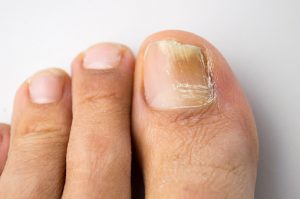
Brittle toenails appear as if the nails have been chewed on, because the nails look uneven and split at the end. Furthermore, even though initial growth of the nail looks good, once it grows beyond a millimeter past the end of the toe, the same chipping and uneven process begins again—meaning you need to keep your toenails quite short to keep them looking good.
There are many different causes for brittle toenails, but the specific condition onychorrhexis refers to an ailment that causes lengthwise ridges on the surface of the nail.
Brittle toenails symptoms
Symptoms of include reduced strength in the toenail, easy breakage, toenails that may be thicker due to an abnormal production of keratin, toenails that are dry and crumble, color changes in the toenail, white spots appearing on the nail bed, and ridges that form on the nail bed.
What causes brittle toenails
As previously mentioned, there are a variety of causes for brittle toenails, some more serious than others. Causes include:
- Hypothyroidism
- Vitamin deficiencies and nutritional problems
- Overuse of chemical products including nail polish
- Excessive exposure to strong soap
- Older age
- Fungus
- Raynaud’s phenomenon, which causes blood circulation to be limited to the fingers and the toes
- Psoriasis, eczema, and other skin conditions
- Lichen planus, which is a non-contagious skin rash
- Hormonal dysfunctions
- Reactive arthritis
- Eating disorders as they contribute to vitamin deficiencies
- Solvents to remove nail polish
- Keeping feet in water for prolonged periods
Uncovering the cause will help your doctor determine what mode of treatment will be most successful in treating your brittle toenails.
Treatment for brittle toenails
Treatments can either target the nail specifically or address the underlying cause. For example, treating hormonal dysfunction, vitamin and nutritional deficiencies, reducing your exposure to chemical and harsh products, and treating other medical conditions can go a long way in improving the appearance of brittle toenails.
Your doctor may also be able to prescribe you medication or topical creams to treat fungal or other infections that may be contributing to brittle toenails.
It takes up to six months for a new nail to grow, so changes are unfortunately not seen overnight. Don’t stress out when you don’t see changes right away. Having patience and watching the changes occur slowly is your best tactic. If there are no results after six month, you may need to change up your treatment method.
Brittle toenails: Home remedies
Home remedies can go a long way in aiding the treatment and easing the appearance of unsightly nails. Home remedies for brittle toenails include:
- Always keeping your toenails clean
- Trim your toenails regularly and properly
- Apply a hardener to the toenail to keep it strong
- Make sure you moisturize your toenails to keep them moist. Good moisturizers include coconut oil or almond oil
- If toenails are dry, try soaking them, and apply a moisturizer when done
- Ensure you are eating a diet rich in vitamins and nutrients. If your diet is missing essential vitamins, then consider taking a multivitamin
- Avoid chemicals on your toenails
- Wear fitted shoes, but not too fitted where your toenail becomes crushed or hits the front of the shoe. An ill-fitting shoe causes your toes to bang up against the front of the shoe
- Follow instructions on antifungal creams if prescribed or recommended
By following these tips, you can have greater success in treating your brittle toenails at home. Soon enough, you will be back to showing off your toes, as you’ll no longer be embarrassed or plagued by brittle and unsightly toenails.